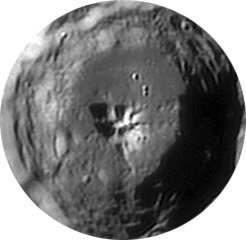Difference between revisions of "December 19, 2013"
| Line 3: | Line 3: | ||
<!-- ws:start:WikiTextHeadingRule:0:<h1> --> | <!-- ws:start:WikiTextHeadingRule:0:<h1> --> | ||
<!-- ws:start:WikiTextLocalImageRule:6:<img src="/file/view/LPOD-Dec19-13.jpg/478459156/LPOD-Dec19-13.jpg" alt="" title="" /> -->[[File:LPOD-Dec19-13.jpg|LPOD-Dec19-13.jpg]]<!-- ws:end:WikiTextLocalImageRule:6 --><br /> | <!-- ws:start:WikiTextLocalImageRule:6:<img src="/file/view/LPOD-Dec19-13.jpg/478459156/LPOD-Dec19-13.jpg" alt="" title="" /> -->[[File:LPOD-Dec19-13.jpg|LPOD-Dec19-13.jpg]]<!-- ws:end:WikiTextLocalImageRule:6 --><br /> | ||
| − | <em>image by [mailto:tosi.philippe@wanadoo.fr | + | <em>image by [mailto:tosi.philippe@wanadoo.fr Philippe Tosi], Pic du Midi, France</em><br /> |
<br /> | <br /> | ||
Craters are like people, but even more so. There is one basic morphology for a human, with lots of minor variations that make individuals relatively unique. For craters the range of variation seems more limited so that craters of similar size tend to look very similar. Except that each has a geographic context that usually provides a unique setting - isolated on a mare, overlapping an older feature, being inside a larger crater, etc. If we strip away the context the similar design of craters becomes more apparent, and they tend to lose their identity. For example, which is this relatively pristine complex crater? How can you tell? Is it as interesting without context? If it were person it might ask, <em>Do you love me for me, or for my friends and family?</em> I think, for craters, it's often the friends and neighborhoods that make a crater a favorite.<br /> | Craters are like people, but even more so. There is one basic morphology for a human, with lots of minor variations that make individuals relatively unique. For craters the range of variation seems more limited so that craters of similar size tend to look very similar. Except that each has a geographic context that usually provides a unique setting - isolated on a mare, overlapping an older feature, being inside a larger crater, etc. If we strip away the context the similar design of craters becomes more apparent, and they tend to lose their identity. For example, which is this relatively pristine complex crater? How can you tell? Is it as interesting without context? If it were person it might ask, <em>Do you love me for me, or for my friends and family?</em> I think, for craters, it's often the friends and neighborhoods that make a crater a favorite.<br /> | ||
<br /> | <br /> | ||
| − | <em>[mailto:tychocrater@yahoo.com | + | <em>[mailto:tychocrater@yahoo.com Chuck Wood]</em><br /> |
This text was originally used with the LPOD of [http://lpod.wikispaces.com/December+20,+2008 Dec. 20, 2008], 5 years ago. The crater was ID'ed immediately and one reader commented: <em>We are too good for this ;)</em> There is less context for this example so I think it will be a little more difficult, but not too much.<br /> | This text was originally used with the LPOD of [http://lpod.wikispaces.com/December+20,+2008 Dec. 20, 2008], 5 years ago. The crater was ID'ed immediately and one reader commented: <em>We are too good for this ;)</em> There is less context for this example so I think it will be a little more difficult, but not too much.<br /> | ||
<br /> | <br /> | ||
Revision as of 18:13, 11 January 2015
Stripped of Context, 2.0

image by Philippe Tosi, Pic du Midi, France
Craters are like people, but even more so. There is one basic morphology for a human, with lots of minor variations that make individuals relatively unique. For craters the range of variation seems more limited so that craters of similar size tend to look very similar. Except that each has a geographic context that usually provides a unique setting - isolated on a mare, overlapping an older feature, being inside a larger crater, etc. If we strip away the context the similar design of craters becomes more apparent, and they tend to lose their identity. For example, which is this relatively pristine complex crater? How can you tell? Is it as interesting without context? If it were person it might ask, Do you love me for me, or for my friends and family? I think, for craters, it's often the friends and neighborhoods that make a crater a favorite.
Chuck Wood
This text was originally used with the LPOD of Dec. 20, 2008, 5 years ago. The crater was ID'ed immediately and one reader commented: We are too good for this ;) There is less context for this example so I think it will be a little more difficult, but not too much.
Technical Details
C.14 + barlow 2x + ACA basler 1300 camera, stack of 400 images.
Related Links
21st Century Atlas chart ?



